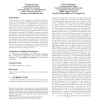Free Online Productivity Tools
i2Speak
i2Symbol
i2OCR
iTex2Img
iWeb2Print
iWeb2Shot
i2Type
iPdf2Split
iPdf2Merge
i2Bopomofo
i2Arabic
i2Style
i2Image
i2PDF
iLatex2Rtf
Sci2ools
GECCO
2007
Springer
2007
Springer
Analysis of evolutionary algorithms for the longest common subsequence problem
In the longest common subsequence problem the task is to find the longest sequence of letters that can be found as subsequence in all members of a given finite set of sequences. The problem is one of the fundamental problems in computer science with the task of finding a given pattern in a text as an important special case. It has applications in bioinformatics, problem-specific algorithms and facts about its complexity are known. Motivated by reports about good performance of evolutionary algorithms for some instances of this problem a theoretical analysis of a generic evolutionary algorithm is performed. The general algorithmic framework encompasses EAs as different as steady state GAs with uniform crossover and randomized hill-climbers. For all these algorithms it is proved that even rather simple special cases of the longest common subsequence problem can neither be solved to optimality nor approximately solved up to an approximation factor arbitrarily close to 2. Categories ...
| Added | 07 Jun 2010 |
| Updated | 07 Jun 2010 |
| Type | Conference |
| Year | 2007 |
| Where | GECCO |
| Authors | Thomas Jansen, Dennis Weyland |
Comments (0)

